AI Chatbots for Construction Workers: Site Support That Actually Gets Used
Taher Pardawala October 24, 2025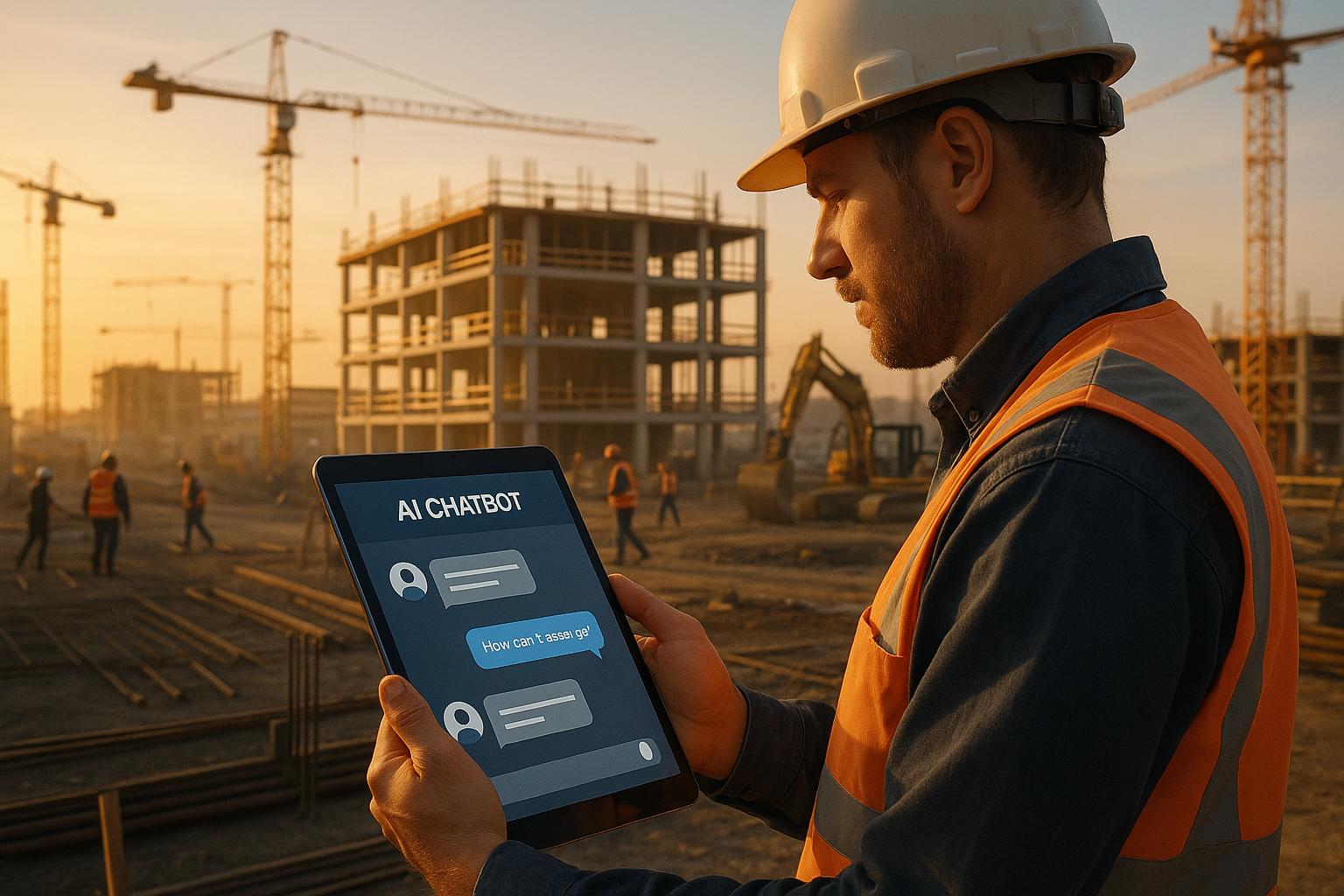
AI chatbots are transforming construction sites by solving everyday challenges like delays in communication, safety compliance, and equipment troubleshooting. Designed for busy, high-pressure environments, these chatbots provide instant answers to safety questions, technical issues, and material management – all through simple voice or text inputs. Workers can access information on the go, even in noisy or offline conditions, making their jobs easier and more efficient.
Here’s what makes them effective:
- Instant Access: Quickly retrieve safety protocols, equipment guides, or project updates without waiting for supervisors.
- Language Support: Overcomes language barriers for diverse teams, improving communication and safety.
- Hands-Free Operation: Voice commands ensure usability, even with gloves or noisy surroundings.
- Offline Functionality: Works without internet, syncing data later when connectivity returns.
- Integration: Connects with existing tools like Procore or PlanGrid for seamless workflows.
AI Chatbot for the Construction Industry [Free Template]
How AI Chatbots Work in Construction
AI chatbots are transforming construction sites by simplifying daily operations, minimizing delays, and ensuring projects stay on track. What sets these tools apart from general-purpose AI is their deep understanding of construction-specific challenges. They’re equipped to handle industry jargon, safety protocols, equipment details, and standard procedures, making them a valuable asset for workers and project managers alike.
Let’s dive into how these tools tackle everyday tasks, improve safety, assist with equipment issues, streamline communication, and manage materials effectively.
Getting Help with Daily Tasks
Construction workers juggle a lot – blueprints, deadlines, and coordination, to name a few. AI chatbots step in as virtual assistants, offering clear guidance, reminders, and task prioritization.
For example, if a worker needs instructions on curing concrete, the chatbot can provide step-by-step guidance, including temperature-specific tips, timeframes, and quality checks. Instead of flipping through manuals or waiting for advice, workers get instant answers tailored to their needs.
These chatbots also handle administrative tasks like logging work hours, requesting materials, and updating task statuses. Whether through voice commands or quick text inputs, they save time and keep operations running smoothly.
Safety Alerts and Rule Compliance
Safety is a top priority on any construction site, and AI chatbots play a crucial role in keeping everyone informed and protected. They provide real-time safety updates tailored to specific situations, such as material handling, weather conditions, or equipment use.
For instance, if wind speeds reach unsafe levels for crane operations, the chatbot can immediately alert workers and suggest alternative tasks. This kind of proactive communication helps prevent accidents before they happen.
Reporting safety incidents is also easier with AI. Workers can simply describe the issue through voice commands, and the chatbot guides them through proper documentation. It ensures accurate reporting and sends the information to the right people promptly.
Need quick access to Material Safety Data Sheets (MSDS) or guidelines for handling hazardous materials? The chatbot can provide this information instantly, eliminating the need to search for physical documents or wait for approval.
Equipment Help and Maintenance
Heavy machinery is at the heart of construction work, but breakdowns and maintenance can slow everything down. AI chatbots act as on-demand support, helping diagnose problems and guiding workers through repairs.
If a machine malfunctions, the chatbot asks targeted questions to identify the issue and suggests possible fixes. This reduces downtime and helps workers decide whether they can resolve the problem themselves or need expert help.
Preventive maintenance is another area where chatbots shine. They track equipment usage, send reminders when servicing is due, and provide detailed maintenance checklists. Workers can also access operating manuals and troubleshooting guides instantly, ensuring they always have the latest technical information.
Better Team Communication
Construction projects rely on seamless coordination between trades, contractors, and supervisors. AI chatbots simplify this process by acting as centralized hubs for communication and project updates.
Workers can use the chatbot to send updates or messages, and it ensures the information reaches the right people based on their roles or locations. This eliminates confusion and keeps everyone on the same page.
Real-time translation is another game-changer. Chatbots can translate messages instantly, breaking down language barriers and ensuring that safety instructions or technical details are understood by everyone on-site.
When project plans change, the chatbot identifies who needs to know and sends personalized updates, ensuring that critical information is communicated quickly and efficiently.
Managing Materials and Supplies
Keeping track of materials is one of the biggest challenges on construction sites. AI chatbots make this easier by monitoring inventory, coordinating deliveries, and ensuring supplies are available when needed.
Workers can ask the chatbot about specific materials, and it provides real-time updates on availability, location, and delivery timelines. This prevents delays caused by missing supplies.
The chatbot also simplifies material requests by generating purchase orders, checking budget approvals, and working with suppliers. This reduces the workload on supervisors and speeds up procurement.
Building AI Chatbots That Construction Workers Will Use
Designing an AI chatbot that construction workers will actually use means addressing the unique challenges of job sites. Workers need tools that fit seamlessly into their routines without adding complexity. A successful chatbot must be intuitive, practical, and designed to handle the realities of construction environments.
Voice Control and Hands-Free Operation
Construction workers often have their hands full – literally. Whether they’re operating heavy machinery, carrying materials, or using tools, stopping to type on a device just isn’t feasible. Voice-activated chatbots offer a solution, allowing workers to get the information they need without putting down their tools.
But voice control on a construction site comes with its own challenges. Sites are noisy, filled with the sounds of machinery, power tools, and chatter. A chatbot must be able to filter out background noise and accurately interpret commands, even when workers are wearing helmets or masks.
Natural language processing plays a huge role here. Workers should be able to speak naturally, without memorizing rigid commands. For example, instead of saying, "Display safety protocol 47", they should be able to ask, "What are the safety rules for working near the crane?" The chatbot needs to grasp context and provide relevant answers.
Push-to-talk functionality can be a game-changer in noisy environments. Workers can activate the chatbot by pressing a button on a radio, phone, or wearable device, ensuring their voice is captured clearly despite the surrounding din.
Integration with Current Tools and Software
Construction companies already rely on a variety of software for tasks like project management, scheduling, and inventory tracking. A chatbot that requires workers to learn entirely new systems is unlikely to gain traction. Instead, it should integrate seamlessly with existing tools.
Platforms like Procore, PlanGrid, and Autodesk Construction Cloud are commonly used on job sites. The chatbot should connect directly to these systems, pulling real-time data and updating information as needed. For instance, when a worker asks about a delivery or project status, the chatbot should provide up-to-date answers from these platforms.
Since workers are constantly on the move, mobile access is critical. The chatbot needs to work across smartphones, tablets, and rugged devices built for tough environments. Cross-platform compatibility ensures that workers have the same experience, no matter what device they’re using.
Integration with communication tools like two-way radios, messaging apps, or email systems can centralize information flow. This way, workers can receive updates through their preferred channels without juggling multiple apps.
APIs are essential for connecting the chatbot to specialized construction software, such as tools for equipment tracking or quality control. This eliminates data silos and keeps information synchronized across systems, making workflows smoother for everyone.
Functionality Without Internet and 24/7 Accessibility
Construction sites often deal with spotty internet connectivity, especially in remote areas or during early project stages. A chatbot must be designed to function effectively even when the internet is unreliable.
Offline capabilities are key. By storing essential data locally, the chatbot can still provide access to safety protocols, equipment manuals, troubleshooting guides, and standard procedures. When connectivity is restored, it can sync with central servers to update information and upload offline data.
Edge computing can keep things running smoothly by processing requests locally instead of relying on cloud servers. This not only speeds up response times but also ensures that critical features remain available during connectivity issues.
Since construction projects often operate around the clock, the chatbot needs to be available 24/7. Workers should be able to get immediate assistance – especially for safety-related concerns – no matter the time of day. Backup communication options, such as cellular networks, satellite connections, or local mesh networks, can help maintain functionality when the primary internet fails.
Making Chatbots Easy for Everyone to Use
Construction teams are made up of people with diverse skills and backgrounds. A chatbot needs to be designed with everyone in mind, ensuring it’s accessible and easy to use.
Language support should go beyond simple translation. The chatbot must understand and respond to construction-specific terms in multiple languages. Visual aids like diagrams, photos, and videos can complement text-based responses, making information clear for workers with varying levels of literacy.
Accessibility features are also important. Options like large text, high-contrast displays, and voice output can help workers with visual impairments. Alternative input methods should be available for those with mobility challenges.
Diverse teams may also have different communication preferences. The chatbot should respect these differences, avoiding assumptions about how workers prefer to receive information or feedback.
Progressive disclosure is a smart approach, offering quick, concise answers upfront with the option to dive deeper if needed. This works well for both experienced workers who need fast confirmations and newer team members who require more detailed guidance.
Finally, training materials should be straightforward and hands-on. Workers learn best by doing, so the chatbot should be intuitive enough for them to start using basic functions right away. More advanced features can be discovered gradually as they become familiar with the system.
sbb-itb-51b9a02
How to Roll Out AI Chatbots Successfully
Rolling out a chatbot successfully takes careful planning and a focus on showing quick, tangible benefits. Construction workers, in particular, need to see how the tool can make their demanding jobs easier without adding unnecessary complexity.
Starting Small and Building on Feedback
A great way to begin is with a small pilot program. Start with one crew or trade, ideally one that’s open to new technology and has supportive supervisors. Run the trial for 4–6 weeks, gathering daily feedback to refine the chatbot’s functionality.
Feedback is key here. During the first week, check in with workers daily to address any immediate issues. After that, use weekly surveys to assess satisfaction and uncover missing features. Don’t just rely on what workers say – observe how they’re actually using the chatbot. This can reveal unexpected ways it’s being used or areas where it’s falling short.
Document both successes and challenges during the pilot. Workers might come up with creative ways to use the chatbot that you hadn’t anticipated, or they might struggle with features you thought were straightforward. Use this information to make quick updates. For example, if voice commands fail near noisy equipment, fix it within days, not weeks. This kind of responsiveness builds trust and shows workers their input matters.
Once the pilot is refined through feedback, the next step is making sure workers feel confident using the system.
Teaching Workers How to Use the System
Effective training is hands-on and happens on-site, using real-world scenarios. Start simple. Focus on the most common tasks first, like asking for safety information, checking schedules, or reporting issues. Avoid overwhelming workers with too many features at once – master the basics, then gradually introduce advanced functions.
Peer-to-peer learning works well in construction. Pair tech-savvy workers with those less comfortable with technology. This approach feels less intimidating than formal training and allows for ongoing support as questions come up naturally during the workday.
Keep training sessions short – 15 to 20 minutes during shift starts or lunch breaks – and focus on one or two features at a time. Provide durable pocket guides with screenshots and step-by-step instructions. Laminated materials that can withstand rough job site conditions, combined with QR codes linking to video tutorials, are especially helpful.
Have someone on-site who knows the system well and can troubleshoot issues immediately. Quick fixes reduce frustration and keep momentum going.
Proper training lays the groundwork for full adoption across the team.
Getting Everyone on Board
Adoption speeds up when everyone sees how the chatbot benefits them directly. Each role – workers, supervisors, and management – has unique concerns that need to be addressed.
For workers, the key question is whether the chatbot will make their jobs easier. Show them how it simplifies tasks like finding information or reporting issues. If they see immediate benefits, they’re more likely to embrace the tool.
Supervisors care about productivity and accountability. Highlight features like automated reporting, instant updates, and easier communication. When supervisors see the chatbot as a tool that helps them manage their crews better, they’ll encourage its use.
Management often focuses on cost, efficiency, and risk. Present clear metrics and timelines to show how the chatbot will save money, reduce errors, or improve safety. Address concerns about training time or potential disruptions with realistic expectations and a solid plan.
Involve representatives from all levels – workers, supervisors, and management – in the planning process. This collaborative approach fosters a sense of ownership and ensures the chatbot meets everyone’s needs. Be upfront about potential concerns, like data collection or job security, and emphasize that the goal is to make work easier and safer, not to replace jobs or increase oversight.
Tracking Results and Return on Investment
To prove the chatbot’s value, track specific metrics and gather worker feedback.
Start with productivity metrics. Measure time saved on tasks like finding information or resolving equipment issues. Compare these numbers before and after the chatbot’s introduction to show its impact. Even small gains can add up significantly on large projects.
Safety metrics are equally important. Monitor incident rates, near-miss reports, and compliance scores. If the chatbot helps workers access safety protocols faster or reminds them of procedures, this should reflect in your data.
Communication efficiency is another area to watch. Look for reductions in radio chatter, fewer calls to supervisors, and quicker responses to inquiries. These improvements directly boost productivity.
Don’t overlook worker satisfaction. Surveys can provide insights numbers can’t. Ask workers if the chatbot makes their jobs easier, if they’d recommend it to others, and what features they’d like to see added. High satisfaction scores suggest sustainable adoption, while lower scores highlight areas for improvement.
Finally, track adoption rates. Monitor how many workers are actively using the chatbot, which features are most popular, and where usage might be dropping off. Low adoption in certain areas could point to training gaps or features that don’t align with actual workflows.
Regular reporting keeps everyone engaged. Monthly dashboards showing usage stats, productivity gains, and worker feedback help maintain support from management. Sharing real-life success stories – like how the chatbot solved a problem or prevented an issue – reinforces its value.
AlterSquare‘s AI Chatbot Solutions for Construction
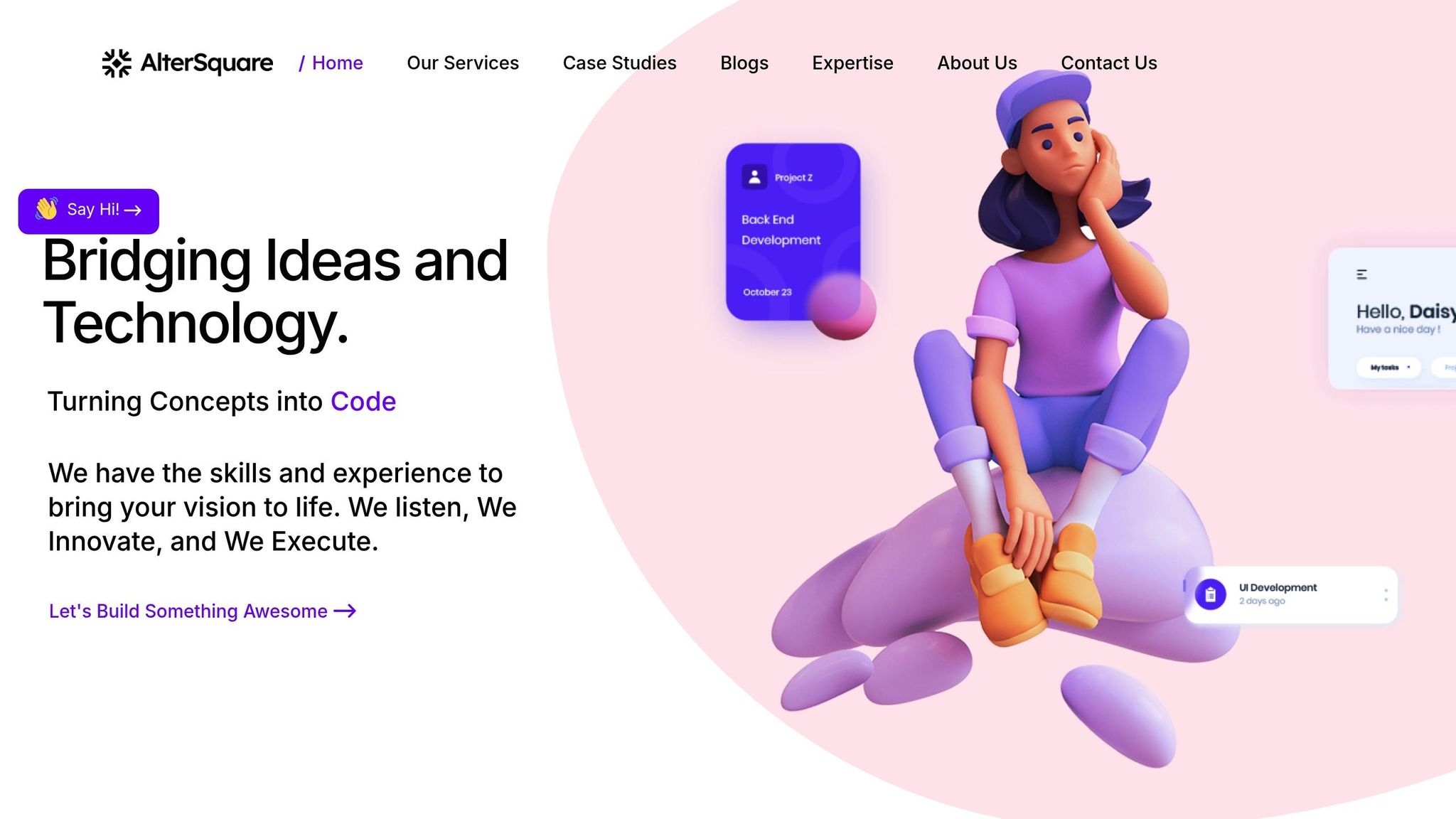
AlterSquare takes a tailored approach to developing AI chatbots designed specifically for the unique demands of construction environments. Their engineering-as-a-service model integrates directly with your team, addressing the practical challenges of job sites and creating tools that workers are eager to use. This method aligns closely with the real-world issues faced on construction sites.
Custom Chatbot Solutions for Job Sites
AlterSquare’s AI-powered chatbots go beyond basic functionalities, offering solutions that seamlessly blend into existing construction workflows. Whether it’s project management software or safety reporting systems, their tools are designed with an in-depth understanding of on-site operations.
They start with a Mobile Tech Readiness Check, evaluating critical factors like WiFi and cellular coverage, device availability, and current workflows. This step ensures that automation is implemented where it will make the most impact, avoiding the pitfalls of deploying technology that doesn’t align with the actual work environment [1].
The chatbots tackle key operational challenges. From simplifying material requests to offering instant access to safety protocols or troubleshooting equipment issues, each solution is customized to address the specific needs of your crew. The goal? Tools that make their work easier, not harder.
All solutions are built to integrate seamlessly with your existing systems, ensuring uninterrupted data flow and streamlined operations.
Real Results from Client Projects
AlterSquare has a proven track record of delivering results. Case studies highlight measurable improvements in areas like revenue, efficiency, and user satisfaction. Their approach includes a 90-day MVP (Minimum Viable Product) program, which focuses on rapid prototyping and testing.
This short timeframe allows for real-world testing across diverse job sites and weather conditions, all while maintaining momentum and stakeholder engagement. By identifying and resolving issues quickly, their iterative process ensures the technology adapts to evolving project needs and regulatory changes.
Step-by-Step Development Process
AlterSquare’s I.D.E.A.L. framework is designed to meet the specific demands of construction sites, ensuring each stage of development is practical and effective. Here’s how it works:
- Discovery and Strategy: This phase dives into the details of construction operations, tasks, and obstacles, shaping the chatbot’s design and training requirements.
- Design and Validation: Prototypes are tested directly with workers to ensure usability before moving to full-scale development.
- Agile Development: Rapid iteration cycles allow for continuous feedback and adjustments, bridging the gap between theoretical design and on-the-ground application.
- Launch Preparation: On-site training is prioritized, with knowledgeable support teams available during deployment to address any immediate issues.
- Post-Launch Support: After deployment, AlterSquare continues to monitor performance, refine features, and optimize the chatbot. As projects evolve and regulations shift, the chatbot evolves too. Budget planning is integrated throughout, ensuring the solution stays within financial limits while delivering clear, measurable returns.
Making AI Chatbots Work for Construction Workers
In the construction world, success often hinges on practical solutions that genuinely address the needs of workers. For AI chatbots to make a meaningful impact, they must simplify tasks, not complicate them. The goal is clear: provide tools that solve real problems for workers juggling demanding and fast-paced environments.
Main Benefits and Key Points
AI chatbots can transform job site operations in several impactful ways. For starters, they provide quick, on-demand safety reminders, helping workers stay compliant without interrupting their workflow.
Features like voice commands and instant text updates streamline communication, ensuring that troubleshooting and maintenance guidance is available right when it’s needed. This cuts down on endless phone calls and minimizes delays caused by waiting for responses or searching for information.
Two features stand out as game changers: hands-free operation and offline functionality. On busy job sites, workers need tools that fit seamlessly into their routines. Chatbots that respond to voice commands and work without constant internet access are far more likely to be adopted and used effectively.
Adoption happens quickly when the technology feels intuitive and requires little to no training. Chatbots that use plain language and deliver immediate, practical value can win over even the most tech-wary workers.
With these benefits in mind, the next step is to plan a rollout that ensures the technology delivers on its promise.
How to Get Started with AI Chatbots
To make the most of AI chatbots, companies need a rollout strategy that aligns with their operational goals while keeping things simple and effective.
Start by assessing your current technology and worker needs. This includes checking cellular coverage at job sites, identifying the devices workers already use, and pinpointing tasks that are time-consuming or prone to errors – areas where automation could make a real difference.
Launch with a pilot program focused on one specific use case. For example, start with material ordering, safety protocol queries, or equipment maintenance reminders. These are practical, high-impact areas where the benefits of chatbots become immediately clear.
Involve workers early in the process. The people who will use the chatbot every day should have a say in identifying pain points and testing early versions. Their input ensures the chatbot addresses real-world challenges and avoids becoming just another unused tool.
Ensure integration with existing systems like project management and safety reporting tools. The chatbot should enhance workflows, not create extra steps or disrupt established processes.
Plan for ongoing support. Job sites evolve, regulations change, and new challenges arise. To keep the chatbot relevant and effective, companies need to budget for regular updates and refinements. Treating the chatbot as a dynamic tool rather than a one-and-done purchase leads to better long-term results and higher worker satisfaction.
FAQs
How can AI chatbots improve communication on noisy construction sites?
AI chatbots are built to improve communication, even in the noisy and hectic setting of construction sites. By handling text-based inputs from team members, these tools cut down on the need for verbal exchanges that can easily be drowned out by the surrounding noise. Workers can quickly send messages through mobile devices or tablets, ensuring that instructions, updates, or questions are communicated clearly.
On top of that, AI chatbots can work with voice-to-text technology, enabling workers to dictate their messages, which are then converted into text. This feature reduces the risk of miscommunication caused by loud environments. The result? Faster, more efficient, and dependable coordination, even in tough site conditions.
What advantages do AI chatbots bring when integrated with construction management tools?
Integrating AI chatbots with construction management tools can bring a range of benefits to on-site operations, making processes smoother and more efficient.
Streamlining efficiency is one of the standout advantages. Chatbots can take over repetitive tasks like scheduling, updating tasks, and managing resource allocation. By automating these processes, teams can minimize delays and ensure projects stay on schedule.
Improved communication is another key benefit. AI chatbots can send real-time updates, reminders, and alerts about changes in schedules or tasks, ensuring everyone is on the same page. This reduces the risk of miscommunication and helps maintain team alignment throughout the project.
On top of that, AI chatbots can help achieve cost savings. They can provide precise budget estimates and enable real-time budget monitoring. This allows teams to make informed adjustments and stick to financial targets. These tools also support better planning by analyzing various scenarios to fine-tune schedules, allocate resources wisely, and optimize project designs.
How do AI chatbots help improve safety on construction sites?
AI chatbots play a key role in improving safety on construction sites by delivering real-time updates and reminders about safety protocols. They can alert workers about the correct use of personal protective equipment (PPE), point out potential dangers, and keep everyone informed about any changes in regulations.
Beyond that, these chatbots simplify tasks like monitoring worker certifications, creating safety reports, and checking compliance with safety standards. By automating these responsibilities, they minimize human error and contribute to a safer and more organized work environment.
Related Blog Posts
- Mobile-First Construction: Bringing Field Operations into the Digital Age
- AI-Powered Estimation: How Machine Learning is Transforming Construction Bidding
- Automated Progress Tracking: How AI Cameras Are Replacing Manual Site Surveys
- AI Safety Compliance: How Smart Cameras Prevent 80% of Construction Accidents

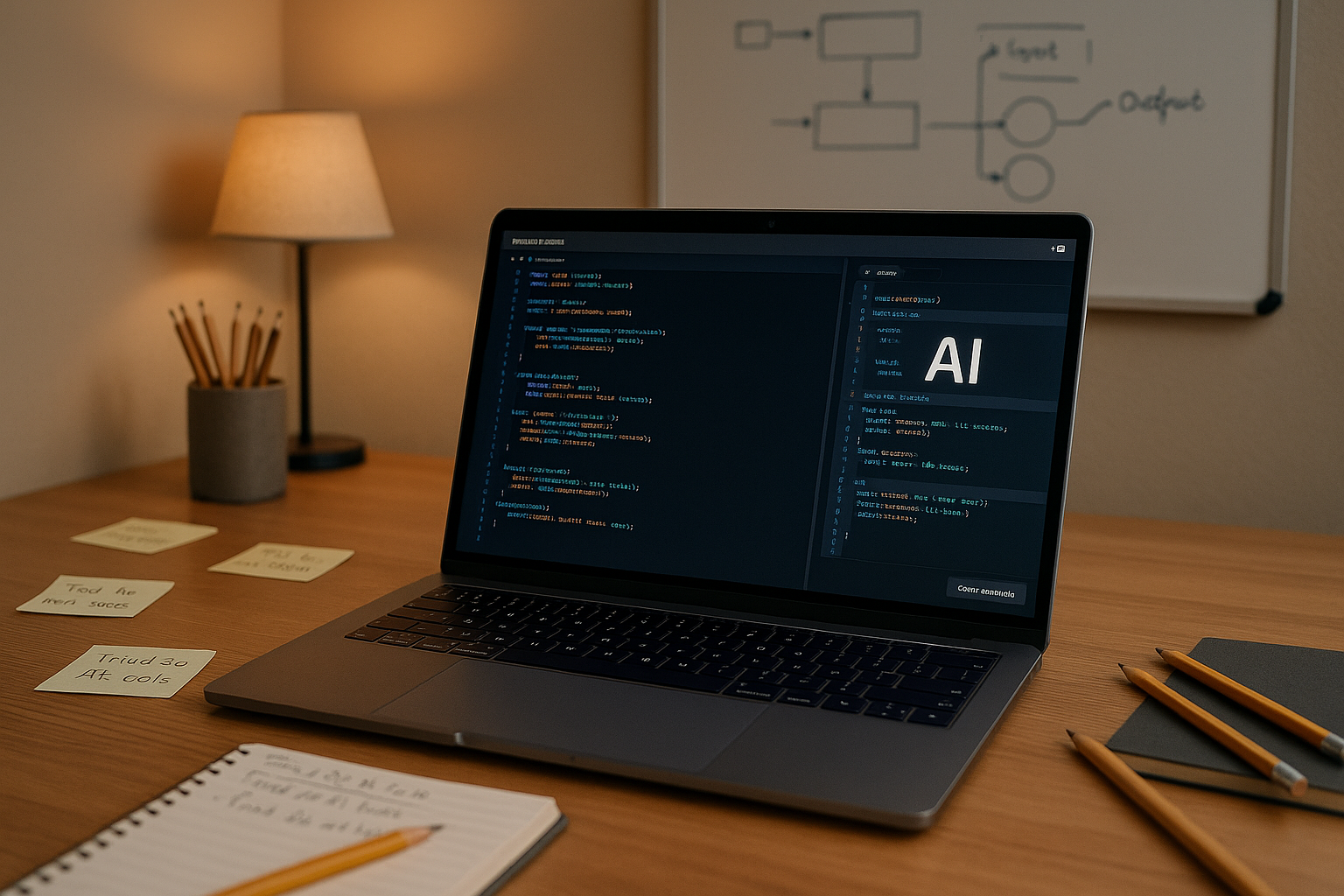
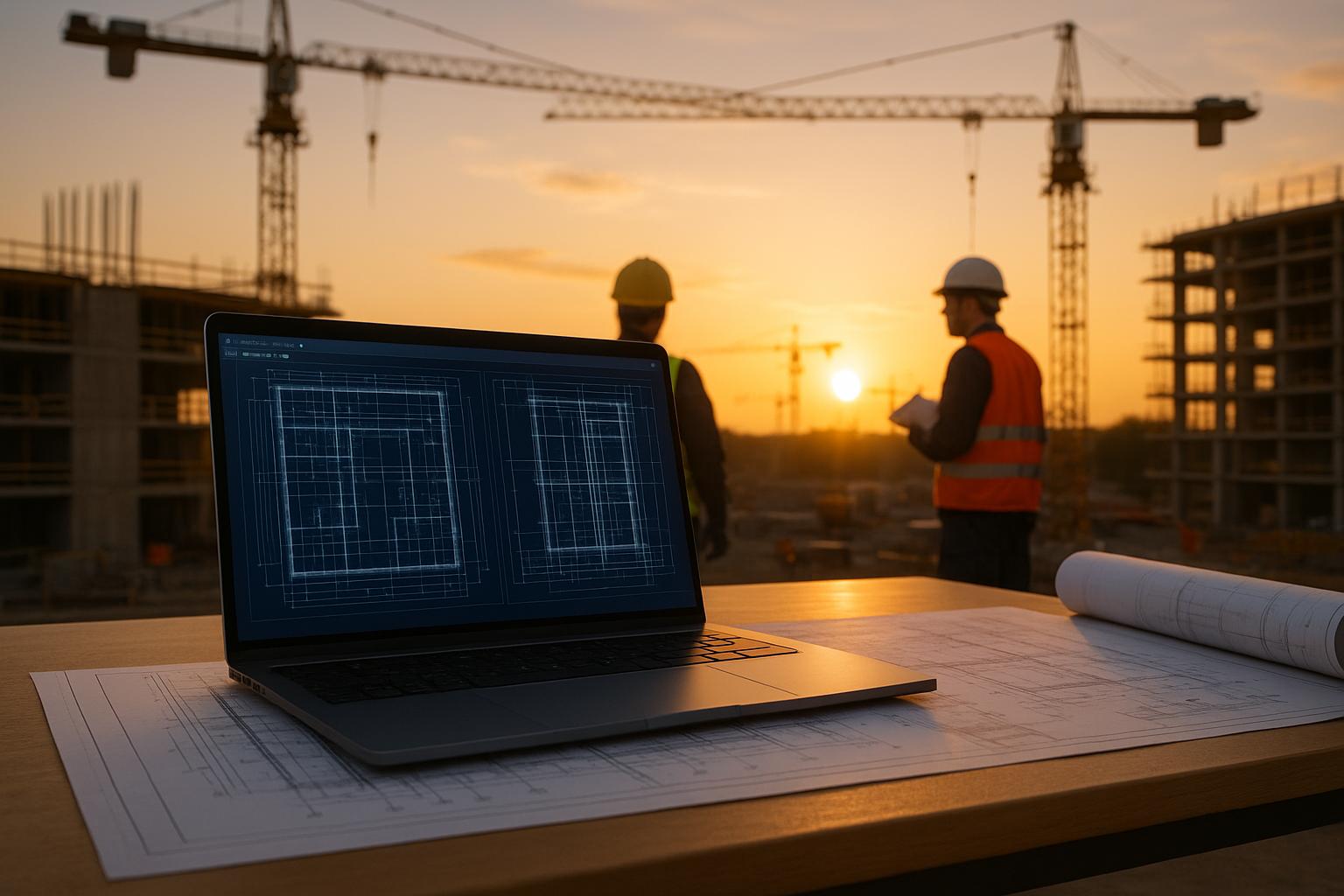

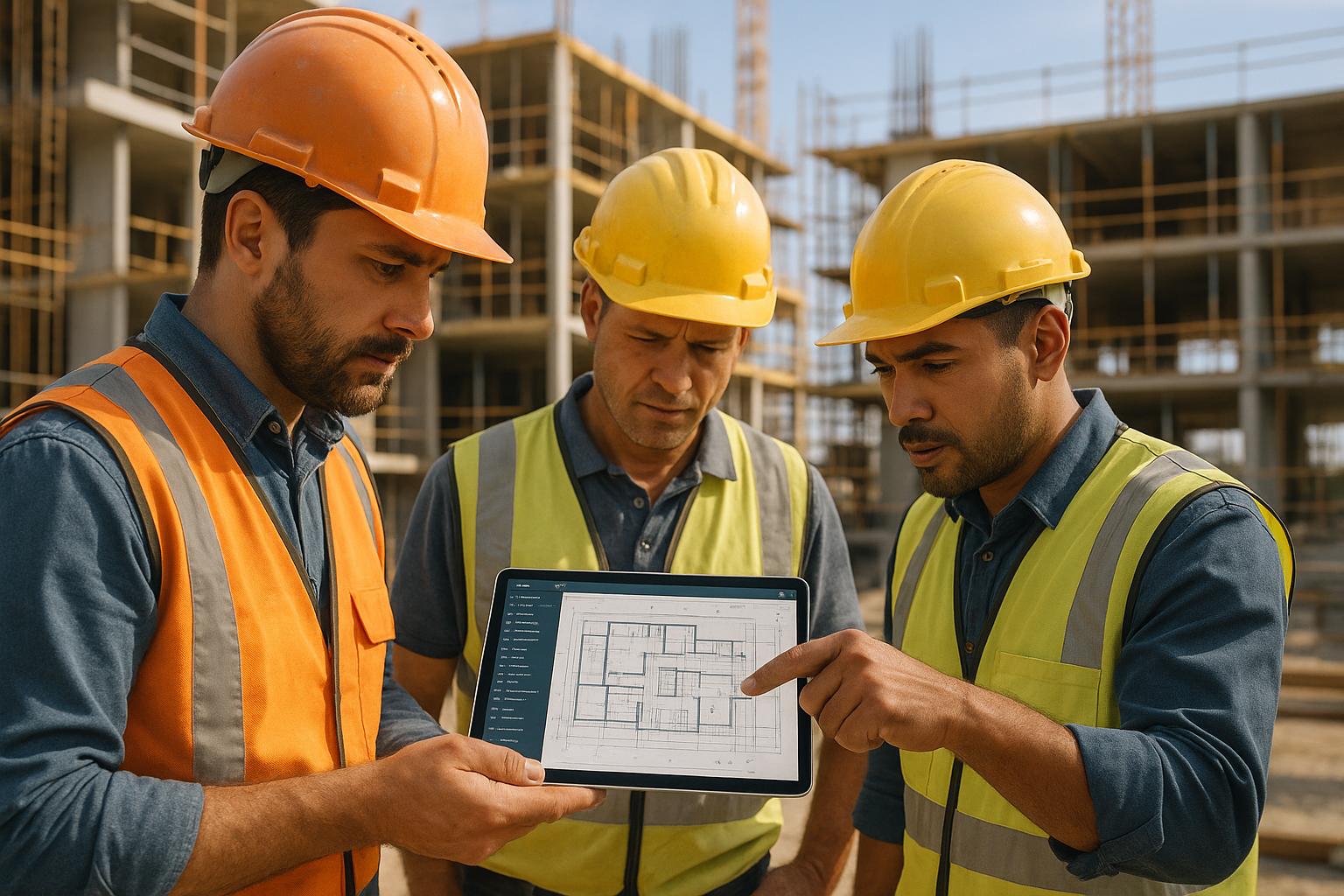



Leave a Reply